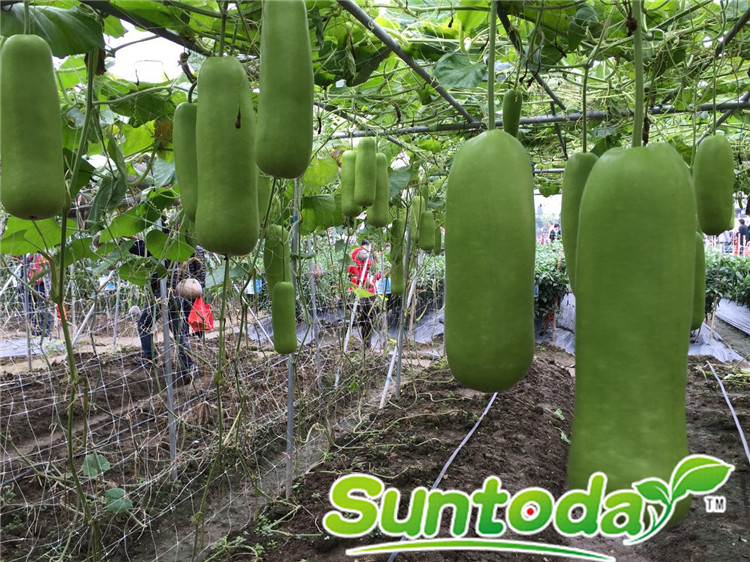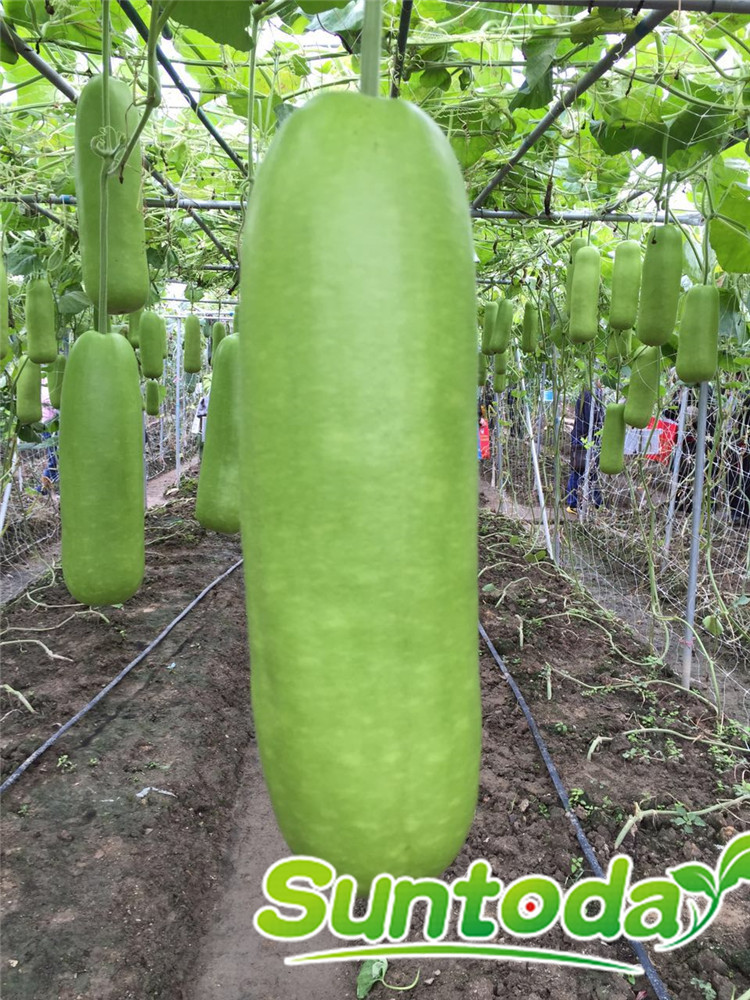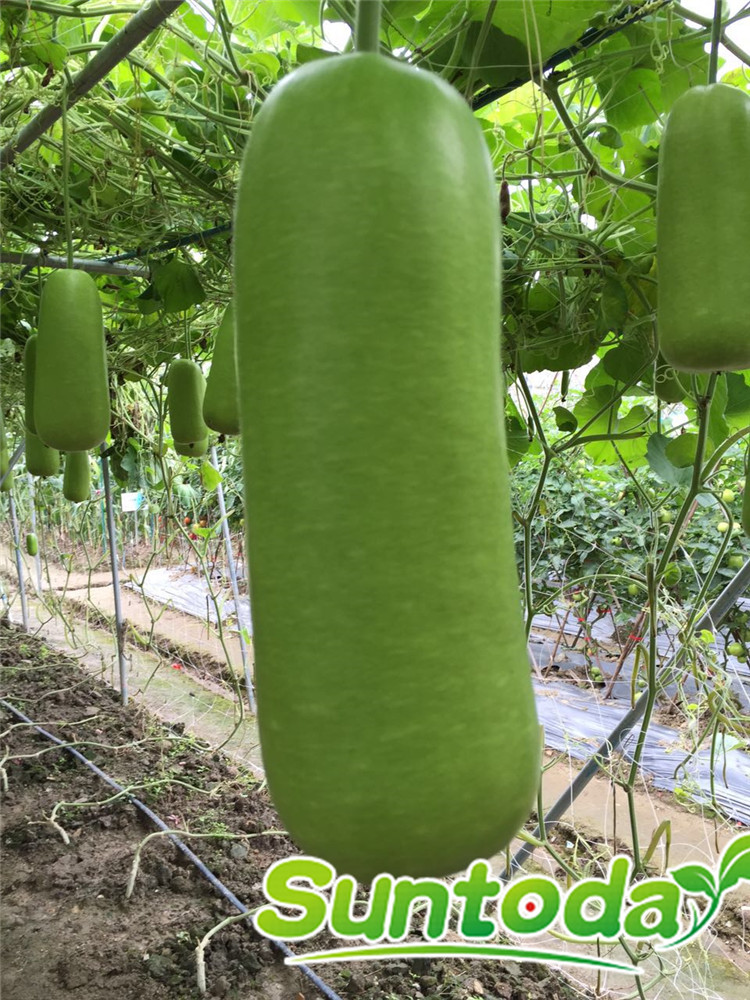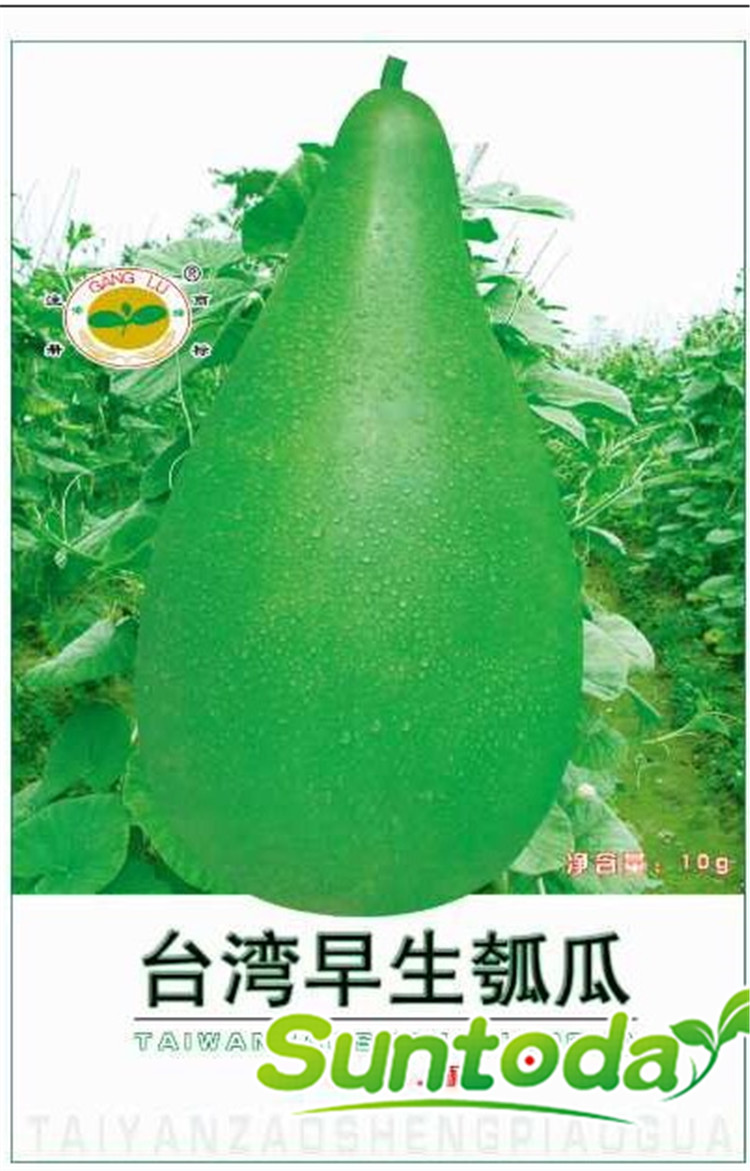Cultivation Guide for Bottle Gourd Variety Series
Time:2016-08-11 Click:
Cultivation Guide for Bottle Gourd Variety Series
Bottle gourd is annual growing vegetable crops, fonding of fertilizer. The plant is thermophilic and not tolerant to low temperature. The seeds start to sprout in 15 degree centigrade, fastest in 30-35 degree centigrade. The suitable growing temperature is 20-25 degree centigrade.1, Biological Characteristics
The roots of bottle gourd stretch herizontally, distributing within the 20cm deep under soil surface, and they are not drought-resistant. The vines are several meters long, with strong branching power. Generally the femal flowes blossom late in chief vine, and they blossom in the 1th-2th node in side vines. In cultivation, the top removal will promotes the growth of side vines, to fructify earlier. The heart shaped leaf is big, thin and tender, with dense white fuzzes and mass evapotranspiration. The white flower is big, with specially long stalk. Most of the male and female flowers blossom at night, in morning and evening in dim light. The artificial pollination will increases the rate of fructification.

2, Sowing Time and Variety Selection
The seeds are generally sown from late January to March in Spring, April to May in Summer, July to August in Fall, and September to November in Winter. It is suggested to choose the varieties such as Tarnal-Precocious bottle gourd, Supper-Precocious bottle gourd, Zhengyuan Yupu bottle gourd, and so on.3, Sowing and Seedling
For the cultivation ahead of time in Spring, Summer and Winter, culture seedlings before transplanting. For the cultivation in Autumn, both transplanting and derect sowing are suitable. Because of the thick shell, the seeds should be soaked for sprouting before sowing. Using nutrient pot to culture the seedlings. The component of the nutrient soil is that, 70% of paddy field soil, 20% of burned soil, 10% of finished organic manure, and 0.2% of calium super phosphate. Each pot sown in 1 grain of seed. Top dressing 1-2 times in the seedling stage, 0.1% compound fertilizer can be used. When the seedlings grow 4-5 pieces of main leaves, they can transplanted with soil.4, Field Preparation and Supply of Base Manure
As bottle gourd has shallow root system, and is not resistant to moisture in the fructification stage, it’s beter to choose loam or clay loam to cultivate on. Prepare the high ridge in 1.6m wide including ditch. The planting distance is about 60-70cm, planting two rows each ridge, about 7200-9600 plants per acre. For the base manure, 9000-12000kg of organic manure, 60-120kg of compound fertilizer and 180kg of calcium, magnesium and phosphate fertilizer per acre.
5, Field Management

5.1, Pruning vines and shelving
For bottle gourd, the A-bracket shelf is usually used. Insert the shelf after the vines draw out. When the chief vine grows out 6 pieces of leaves and is about 50cm high, carry out top removal. After the side vine fructifying, top removal for the second time, remaining 4-6 pieces of leaves, so as to promot the fructification of the tertiary vine. After that, let the vines grow free, to reach high yield and early maturity.5.2, Artificial Pollination
For the early maturing cultivation in Spring and late-Autumn, the pollination by insects will be insufficent because of the low temperature and Spring rain, it is necessary to supply artificial pollination for supporting. The method is that, choose the male flower which will blossom that day in 3-4 p.m., and daub male anther onto the stigma of female flower in 4-5 p.m. when the male flower blossoms.5.3, Fertilizer and Water Management
The bottle gourd fructifies in high quantity, and it need lots of fertilizer and water. Supply seedling promoting fertilizer once after survival from setting. Each acre supply 12-18kg of urea, and once more in 7-8 days. Before the vine draws onto the shelf, supply 30kg of compound fertilizer per acre. After fruiting, top dressing once after two times of harvest, by 60-90kg of compound fertilizer or 300kg of micro fertilizer. Bottle gourd is fond of moist soil, pay attention to the drainage in Spring and irrigation in Summer, to keep the soil in moist condition.6, Harvest

The gourd grows rapidly and should be harvested in time. The gourd is in light green when young, with dense white fuzzes. After fully growing up, the skin turn to a little white, with sturdy and high resilient flesh. The gourds harvested at this time is in best quality. Generally, the gourd can be harvested 15-20 days after flower dropping in early Spring, and 10-14 days only in Autumn.
7, Reasons of Bitterness and Preventive Measures.
The gourd sometimes turns bitter, and will greatly impact people’s health after eating. The bitterness is determined by genetic factors. After crossbreed in different genetic varieties, the gene in the later generation will be complimentary to create gourd glucoside, which make the gourd tastes bitter. Therefore, the bitterness has nothing to do with the environment and cultivation techniques.Measures to prevent is that, when introducing varietities from other places, crossbreed them with the local varieties, to see weather they are of the same genotype. If yes, the varieties can be introduced, otherwise, they can not.
8, Prevention and Control of Diseases and Pests

8.1, Diseases
8.1.1, Blight diseaseIn the early disease, use 500 times of 50% carbendazim WP, or 2000 times of 2.5% fludioxonil for root pouring and leaf spraying, or use 1000 times of 71% Ailisha WP or 200 times of 10% cupric amino-acid complex aqua, for root pouring, 200ml for each plant, and pour once more in 10 days, continue for 2-3 times.
8.1.2, Anthracnose disease
In the early disease, use 1500 times of 50% sporgon(prochloraz manganese chloride complex) WP, or 600 times of 70% thiophanate methyl WP, to spray for 2-3 times in 7-10 days interval.
8.2, Major Insect Pests
8.2.1, WhiteflySpray 3000 times of 10% Imidacloprid or 3% acetamprid, 5000 times of 25% Actara water dispersant, or 2000-3000 times of 50% pirimicarb WP.
8.2.2, Huidobrensis
Spray 3000 times of 1.8% abamectin EC, or 1000 times of 25% nurelle EC, once in every 10 days, continue for 2-3 times.
8.2.3, Spider Mite
Spray 3000 times of 1.8% abamectin EC or 2000-3000 times of 20% fenpropathrin EC, once in every 10 days, continue for 2-3 times.

